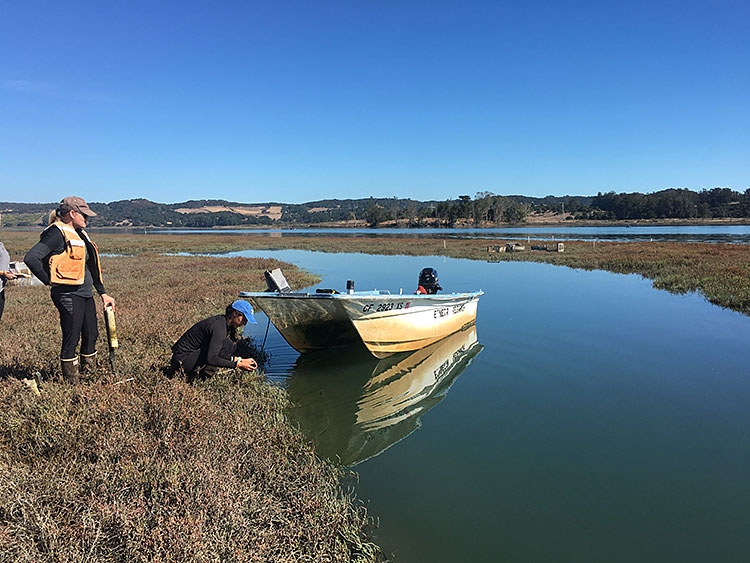Sea-level rise threatens much of California’s iconic coastline. To maintain ecosystem services and functions, coastal managers and policymakers are exploring nature-based solutions such as wetland creation and restoration.

Kat Beheshti and team anchoring the boat before starting field work. • Photo courtesy of Kat Beheshti
Wetlands such as Elkhorn Slough (recognized by the Ramsar Convention as a “Wetland of International Importance”), are known for their ability to protect coastlines from rising seas. Best practices around wetland creation and restoration are always evolving and are based on the best available science.
In the past, ecologists have emphasized the importance of physical factors (such as elevation and hydrology) in driving how wetlands operate, but according to a new study in Elkhorn Slough published Jan. 5 in PLOS ONE, biological and physical factors also play an important role in driving marsh recovery.
“It’s estimated that the estuary has already lost 70% of its historical salt marsh habitat, which is quite alarming,” said lead author Dr. Kathryn Beheshti.
The majority of the marsh loss in recent years has been from the formation and expansion of pannes, or poorly drained mud depressions devoid of vegetation. The researchers were eager to gain a better understanding of what was making pannes expand so quickly.
Beheshti and her co-authors conducted a two-year field study tracking panne dynamics in the estuary.
“Pannes often result in pooling water, and even salt-tolerant plants like pickleweed don’t like to be underwater for long periods of time, especially anoxic, high sulfide water,” Beheshti said.
Over the study period, pannes were observed contracting, and the marsh recovering. The researchers found that marsh recovery along panne edges was fastest where pannes were small, shallow, and at relatively high elevation.
Annakate Clemons (from left), Kat Beheshti, and Hannah Levy collecting molds of crab burrows in Elkhorn Slough salt marshes • Photo courtesy of Kat Beheshti
They also found that pannes showing signs of deposition of sediment and that had good drainage due to high densities of crab burrows were quicker to contract than those that were eroding or had poor drainage (fewer crab burrows).
“It really all points to drainage, and crabs in particular, as the primary engineer in the system … if the marsh surrounding the pannes has few burrows, the water in pannes, especially deep, low elevation pannes, drains more slowly which drowns the marsh plants, and recovery is slower,” added Beheshti.
The PLOS ONE study shows how context-dependent crab effects are in the estuary.
Parallel work led by the same lead author published earlier this year in Ecosphere, showed that along tidal creek edges prone to erosion, crabs negatively affect marsh plant biomass and soil structure, therefore degrading marsh resilience to erosive processes.
Earlier this fall, Gov. Newsom signed a budget bill which includes $500 million for coastal resilience. Additionally, the California Ocean Protection Council continues to work with partner agencies to “…ensure an additional 10,000 acres of coastal wetlands will be protected, restored or created by 2025, and the acreage of coastal wetlands [increased] … by 20% by 2030 and 50% by 2040.”
This study comes at an opportune time in the state, when much of the focus is on how to protect and create wetland habitat. As this study and complementary work shows, these systems are complex, and management decisions should incorporate those complexities.